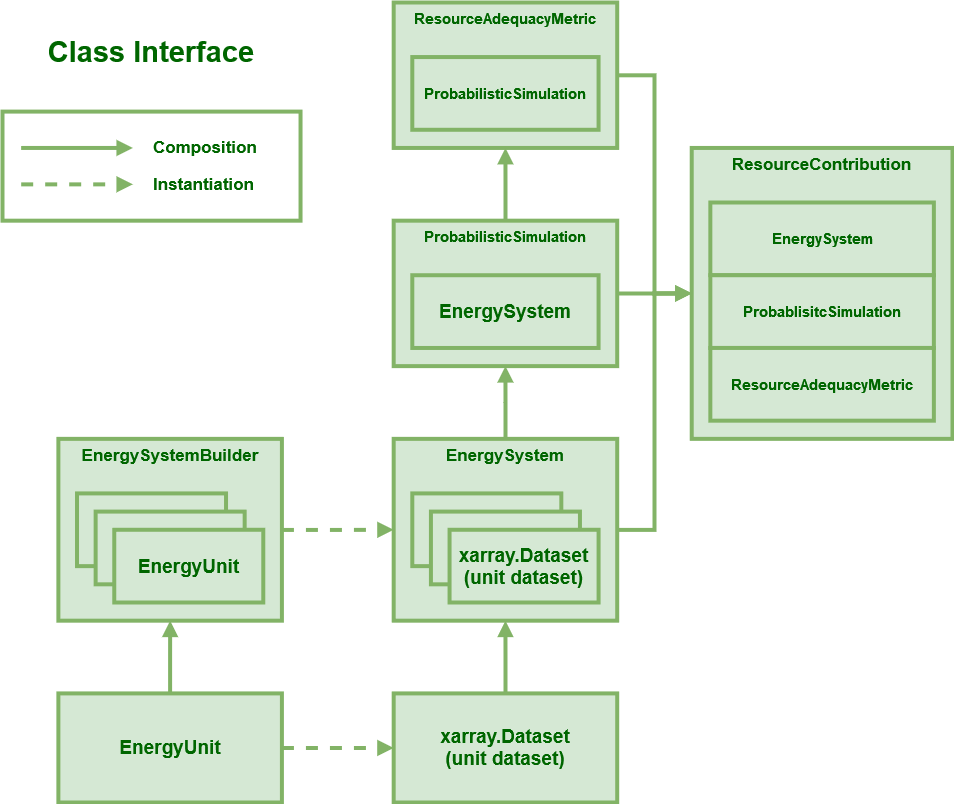Reference¶
Motivation¶
Understanding the resource adequacy of an energy system, or its ability to meet demand, is a critical task for researchers studying energy transition, cross-sectoral system evolution, and energy system operation. Researchers in the Advancing Sustainable Systems through low-impact Energy Technologies (ASSET) Lab and in institutions globally need usable research-grade tools to quantify resource adequacy as part of their multi-dimensional studies. The ASSET lab resource adequacy package (assetra) seeks to meet this need, with the overarching goal to quantify the resource adequacy of energy systems while being flexible, extensible, and easy-to-use for energy researchers.
Interface Overview¶
The assetra object-oriented interface is shown in figure 1 and is best interpreted as a bottom-up model.
EnergyUnit objects, such as demand centers and thermal generators, are added to the EnergySystemBuilder.
The EnergySystemBuilder compiles energy units into EnergySystem objects (see [1] to understand the motivation for this distinction).
EnergySystem objects are attached to ProbabilisticSimulation objects whose responsibility is to generate and store probabilistic net hourly capacity matrices for a large sample of Monte Carlo trials. The net hourly capacity matrix of a ProbabilisticSimulation is a two dimensional matrix representing net system capacity for each Monte Carlo iteration. The net hourly capacity matrix of a ProbabilisticSimulation is a two dimensional matrix representing net system capacity (demand minus capacity) for each Monte Carlo iteration.
ProbabilisticSimulation objects are attached to ResourceAdequacyMetric objects, who quantify resource adequacy, typically as a function of the net hourly capacity matrix.
In addition to resource adequacy, the assetra package quantifies resource contribution of additional resources to an energy system, specifically with effective load-carrying capability (ELCC) metric. Per definition, an EffectiveLoadCarryingCapability object computes the resource adequacy of a base EnergySystem, and then iteratively finds the constant load that can be served by additional resources at the same base resource adequacy level. Because the computation of resource adequacy depends on both the simulation parameters and the selected resource adequacy metric, the EffectiveLoadCarryingCapability object is composed of a base energy system, as well as a ProbabilisticSimulation object and ResourceAdequacyMetric type.

Figure 1: Class interface.¶
Several of the core types in the assetra model are defined as abstract base classes. Abstract interfaces allow for interchangeability and enable users to extend functionality, for example, by creating custom unit types and resource adequacy metrics without modifying the simulation framework. See the usage page for an example. Figure 2 shows the abstract base classes and their derived types.

Figure 2: Derived types used in the assetra model.¶
Assumptions¶
- Static Units
Static units are instantiated with hourly capacity profiles.
Static units always contribute their full hourly capacity.
Demand profiles, instantiated as DemandUnit objects, are treated identically to static units but with a negative contribution.
- Stochastic Units
Stochastic units are instantiated with hourly capacity profiles and hourly forced outage rates.
Stochastic unit outages are sampled independently in each hour.
Stochastic units contribute zero capacity in hours where unit outages occur, otherwise they contribute their full hourly capacity.
Stochastic units are well-suited to model thermal, solar, and wind generators.
- Storage Units
Storage units are dispatched with a greedy policy to minimize expected unserved energy. When net capacity exceeds demand, storage units charge. When system demand exceeds capacity, storage units discharge. Both charging and discharing are limited by the rated power capacity of the unit.
Storage units are dispatched sequentially according to the order in which they are added to the system.
Storage unit efficiency deratings are applied in equal part on charge and discharge.
Storage units are initialized with full state of charge.
Storage units are well-suited to model battery and pumped hydro storage [3].
- ProbabilisticSimulation
Probabilistic simulations dispatch unit datasets in order of type. The established order is DemandUnit, StaticUnit, StochasticUnit, StorageUnit [2].
